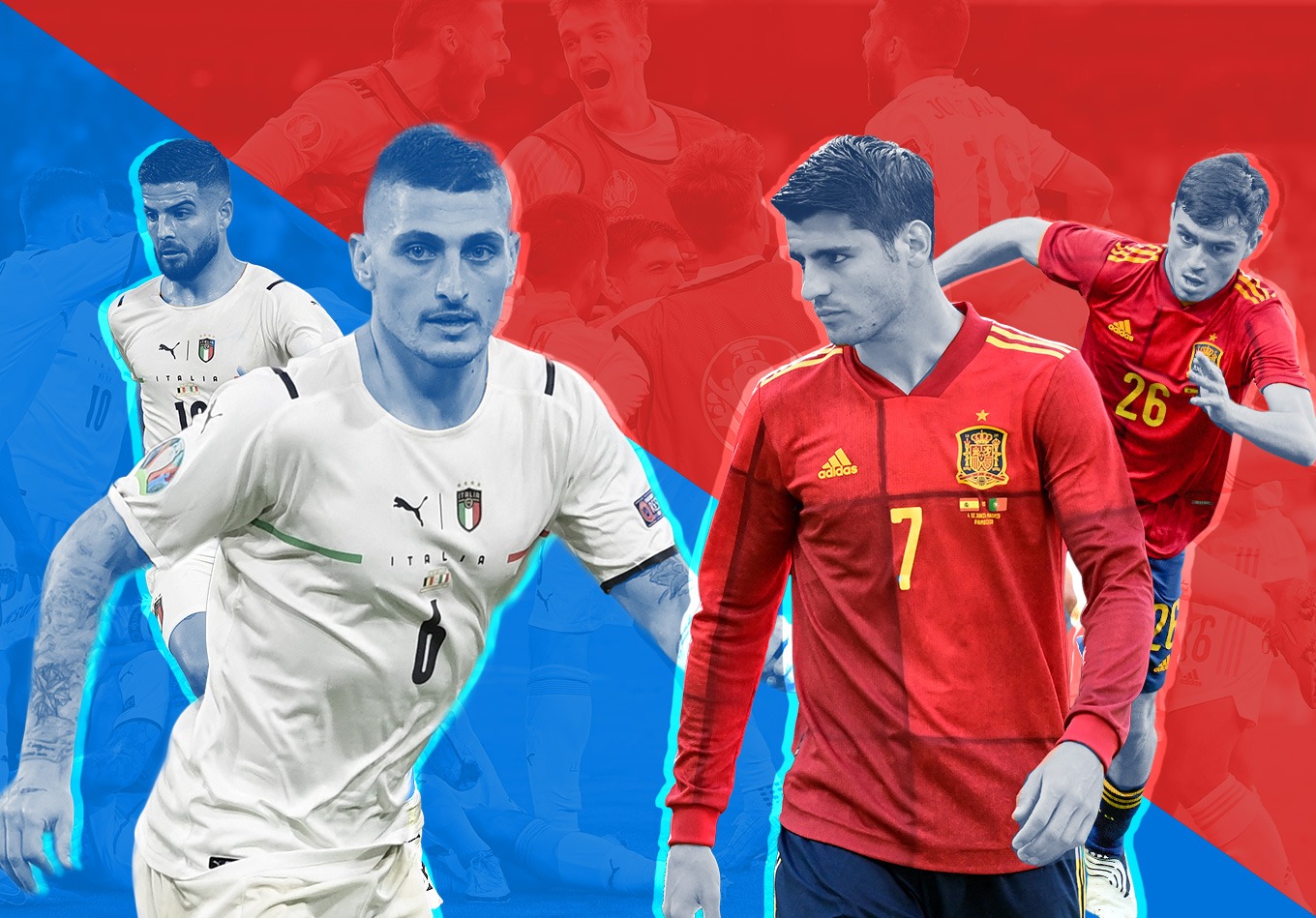For the fourth European Championship in succession, Italy and Spain will face off in the knockout stages. For Italy, one cagey initial 90 minutes against Austria aside, progress has been serene. Four wins from five and a positive goal difference of nine. For Spain, it’s been anything but steady; sneaking past Switzerland on penalties, Croatia in extra-time after a chaotic 90 minutes and making hard work of the group stage.
Here are five tactical trends to look out for as the two European giants meet under the Wembley arch on Tuesday.
1. Analysing Each Side’s Style of Play
With Italy arguably being the best team to watch so far in the tournament, Roberto Mancini’s side have come a long way in a short space of time after not qualifying for the 2018 World Cup. That phrase has a double meaning associated to The Azzurri as it is also reflective of their style when in possession of the ball too.
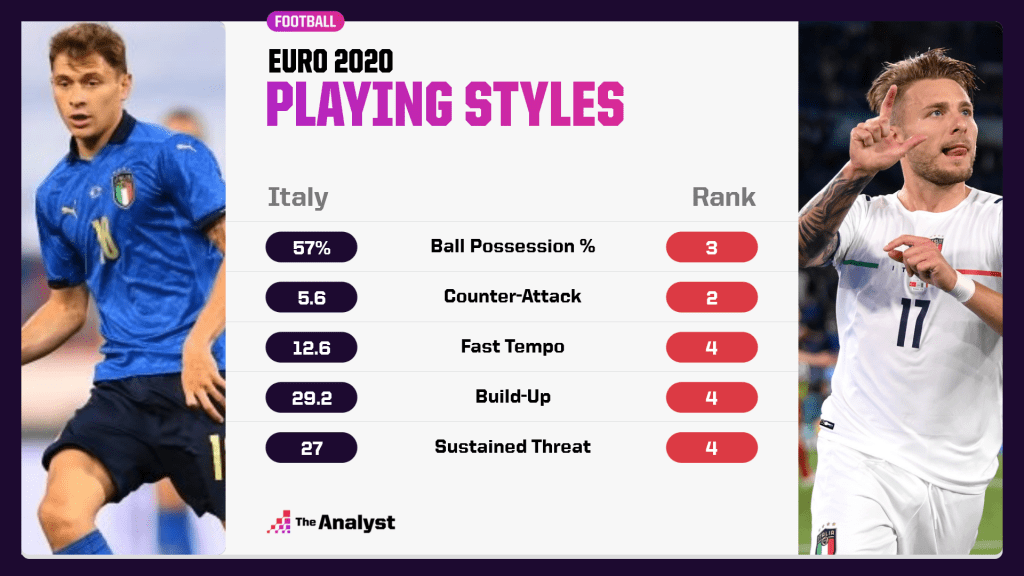
Looking at Stats Perform’s Playing Styles model, Italy rank in the top five across the majority of metrics, showing their superiority in possession. The Fast Tempo metrics adds context to Italy’s possessions, showcasing their ability to receive and then quickly move the ball onto another teammate within one or two touches. We credit a side with an individual fast possession when the player releases the ball to a teammate in less than two seconds or when the player dribbles at a high tempo in the opposition’s half.
Moving the ball in this way not only means that their opponents will find it hard to get close to the ball carrier to overturn possession, but it also allows the team in possession to shift compact defences from their set position to create exploitable gaps. Italy can often be seen recycling the ball around their defence to quickly move the ball from one side of the pitch to the other to create such openings.
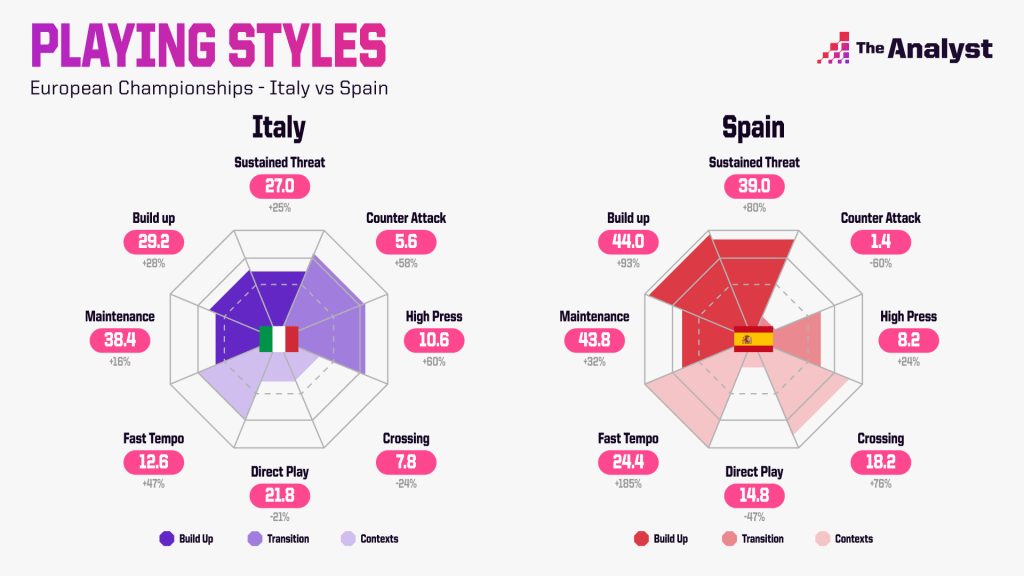
Transition, transition, transition – those words must be bellowed across Italy’s training pitch as their whole campaign has been influenced by their ability to hit opponents on the counterattack once possession has been regained. They rank second in Euro 2020 for their involvements in the counterattack phase per match (5.6), which is over two involvements (or 58%) higher than the competition average. Credit to Mancini and his players, they have been really efficient in this phase too, creating a shot during 2.4 of those attempts.
Lining up against them will be Spain, and with Luis Enrique at the helm, they are stylistically playing the one way in which Spain know how to play – by dominating the ball.
Leading the tournament with 72.5% ball possession, 10.7% higher than second place Germany, Spain have dominated across all phases.
Averaging the highest number of passes per sequence at 5.5, the Spanish move possession laterally very quickly, but slow down when moving the ball vertically towards their opponent’s goal, with the fifth slowest direct speed in the competition:
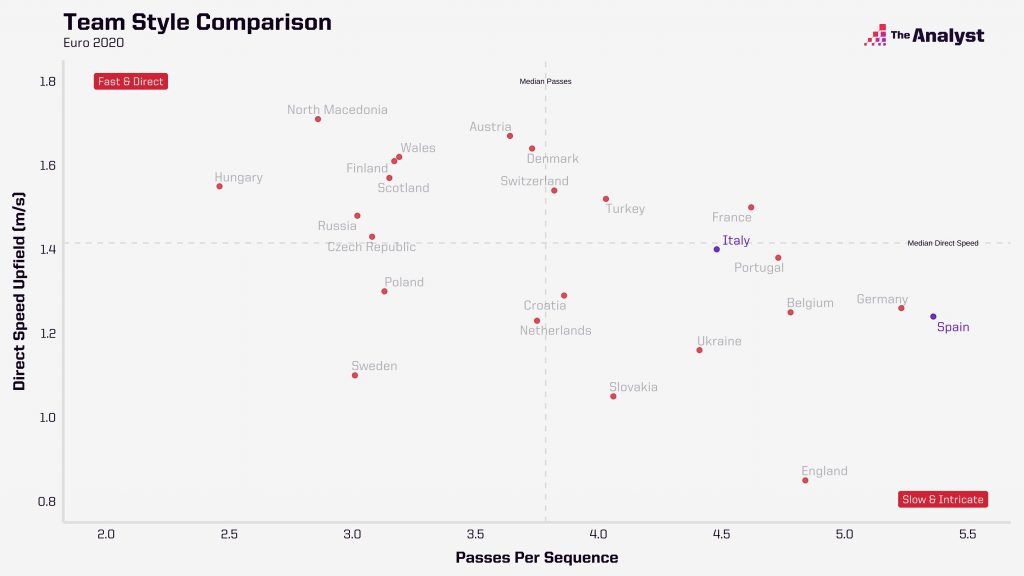
Expect both teams to control possession at varying times throughout the game, with momentum shifting back and forth, but which players will be key to helping their team progress through to the final of the Championships?
2. How Badly Does the Loss of Spinazzola Hurt Italy?
Up until this point, Euro 2020 has been a tournament where the spotlight has shone on right-footed left-backs. There have not been many better performers than Roma’s Leonardo Spinazzola, who unfortunately will miss the semi-finals after rupturing his Achilles in the previous game versus Belgium. It is anticipated that Mancini will look towards Emerson Palmieri, a former Roma player, to replace him.
With Emerson playing the full ninety minutes against Wales in the group stages, where Italy had their tournament-high possession percentage at 69%, and making another appearance as a substitute versus Belgium, we can get an initial comparison of what the Chelsea full-back offers in absence of their usual starter – albeit a smaller sample size than usual.
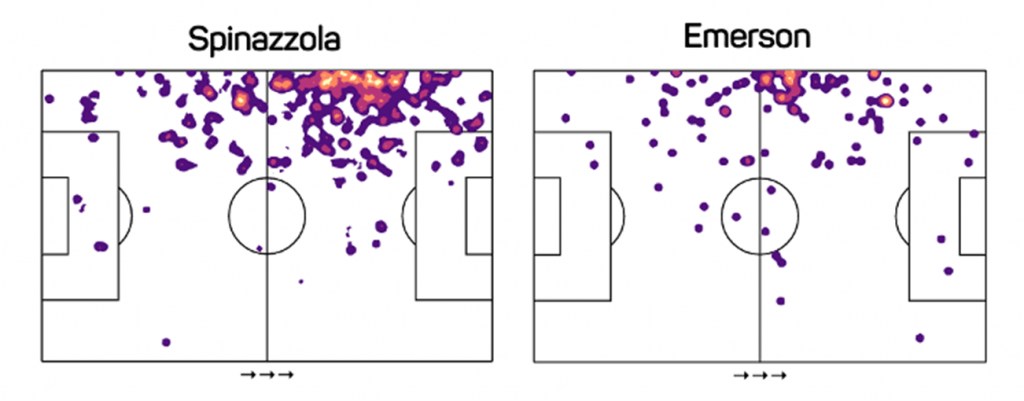
Emerson has taken up a slightly deeper role than Spinazzola, with his ball receptions occurring closer to his own goal. Similarly, looking at both player’s heatmaps above shows that Mancini is instructing his wing-backs to keep the width for their team by occupying the space as close to the touchline as possible. Maintaining this width stretches the pitch, which increases the distances that defending players have to cover if they are to press the ball.
The ideal scenario is that the width is created on both sides of the pitch, as that will create additional space in the inside, allowing players such as Marco Verratti and Jorginho to have a heavier influence on the outcome of the game.
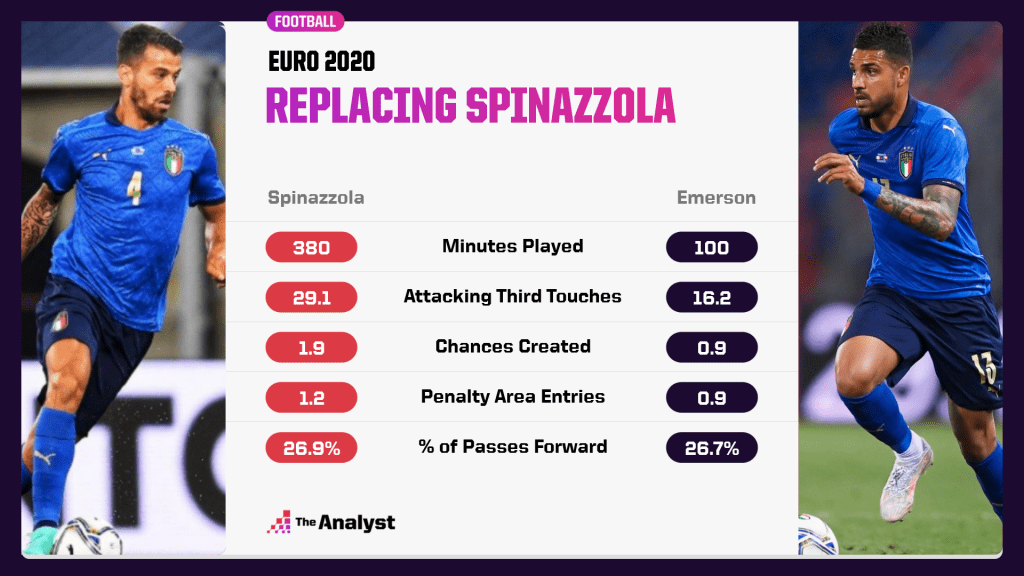
Emerson’s involvement in the Wales game saw him player a safer, less advanced role, as evidenced by the differences in his touches in the final third. Although the difference in 280 minutes between the two does not provide a huge gulf in any other numbers, there’s a chance we will see Emerson’s chance creation starting from a deeper area.
No doubt Spinazzola will be a huge loss for Italy, but by no means is his replacement significantly weaker. We may see a slight tactical change in the way Italy attack as we do not expect to see Emerson penetrate the opposition’s penalty area with too many darting runs. An observation to note could be the increased usage of the right side as a consequence of the line-up change, where Berardi could move from being an outlet to being a primary option for ball possession.
3. Can Spain Get Pedri on the Ball?
It’s been a life-changing 18 months for Pedri. Plucked from second-tier club Las Palmas, the midfielder became an integral part of Barcelona’s midfield in 2020-21 and made his Spain debut in March this year in a World Cup qualifying match against Greece.
The fact he made his international debut just three months before Euro 2020, had only played four matches prior to Euro 2020 and yet is now seemingly an indispensable member of the squad tells you everything you need to know about his talents. Pedri has played 509 out of a possible 510 minutes so far. For an 18-year-old in a major tournament, Luis Enrique has put some serious trust in him.
So, why the trust? What does the diminutive midfielder bring to this Spanish side? The answer is: a lot.
For a start, Pedri is integral to Spain’s shot creation. His involvement doesn’t always show up in traditional metrics like assists, or even in chances created because he doesn’t always play the final pass. But his involvement in Spain’s attacking build-up to shots is second to none. And we literally mean second to none. He’s been involved in more shot-ending sequences (35) than anyone else in the competition.
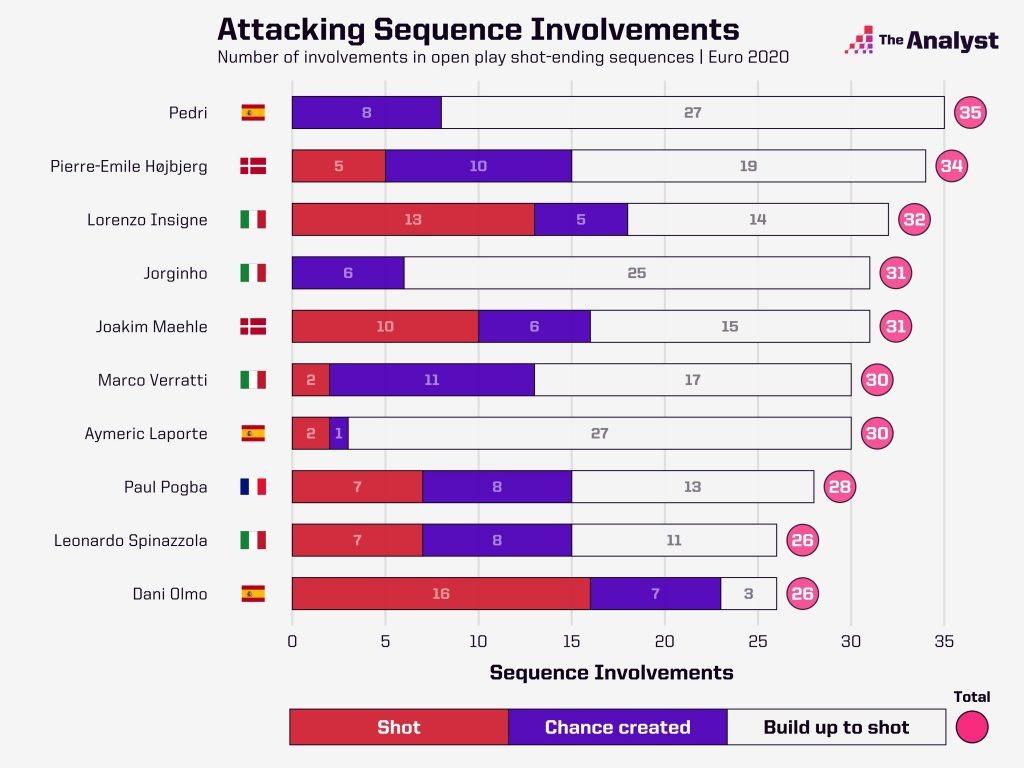
Not only that, but the potency of those attacks has been the most dangerous in Euro 2020, with his involvement in Spain’s open-play sequences worth 7.8 xG, more than any other player.
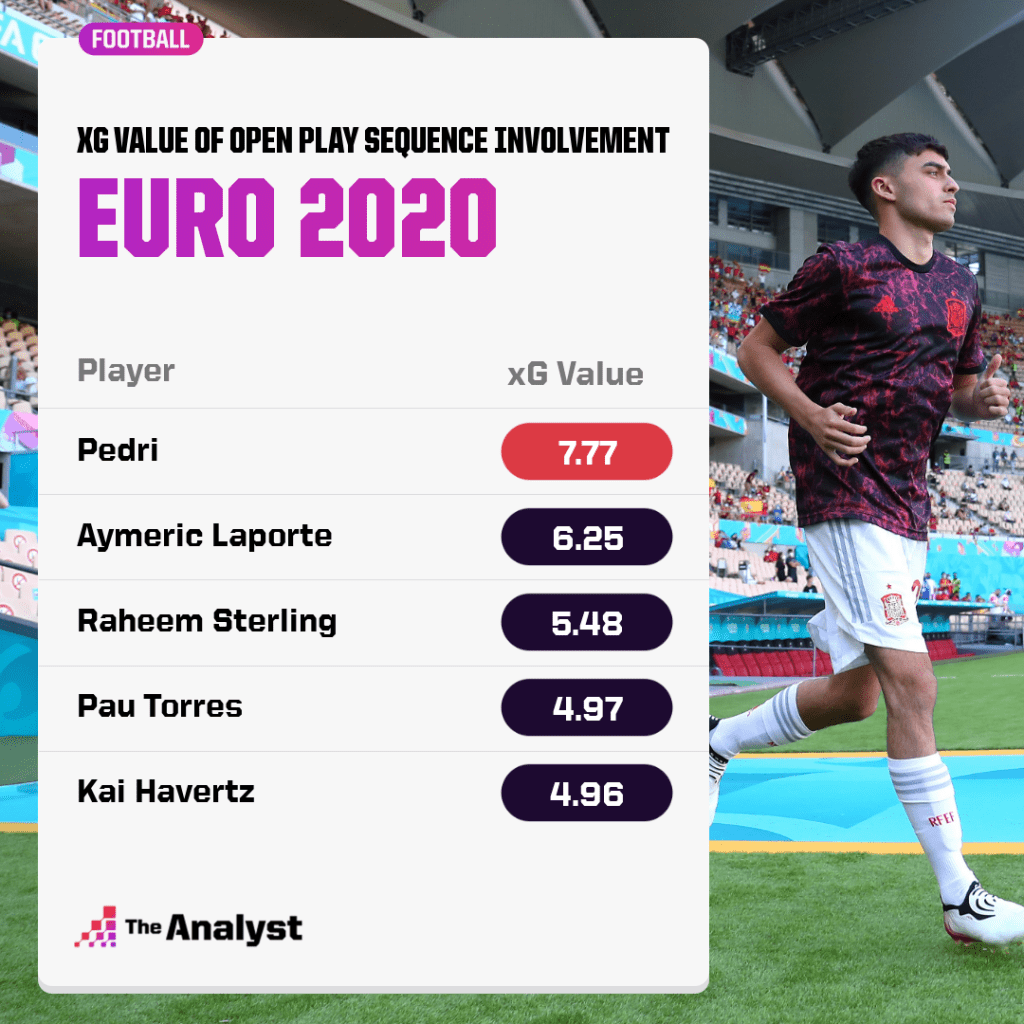
And the way he does that is clear. Of Spain’s midfielders, Pedri is by far and away their biggest ball progressor, doing this through his fantastic ability to carry the ball. He frequently looks to dribble forward with the ball at his feet, before passing the ball to teammates in space. Pedri makes almost 15 progressive carries per 90 minutes – essentially how many times a player carries the ball more than five metres toward the opposition goal. Compare that to Koke (7.6), Busquets (6.1) and Rodri 4.1 and Pedri’s role in that midfield becomes very clear.
Looking at his carry map below shows he is a hive of chaos on the inside left channel.
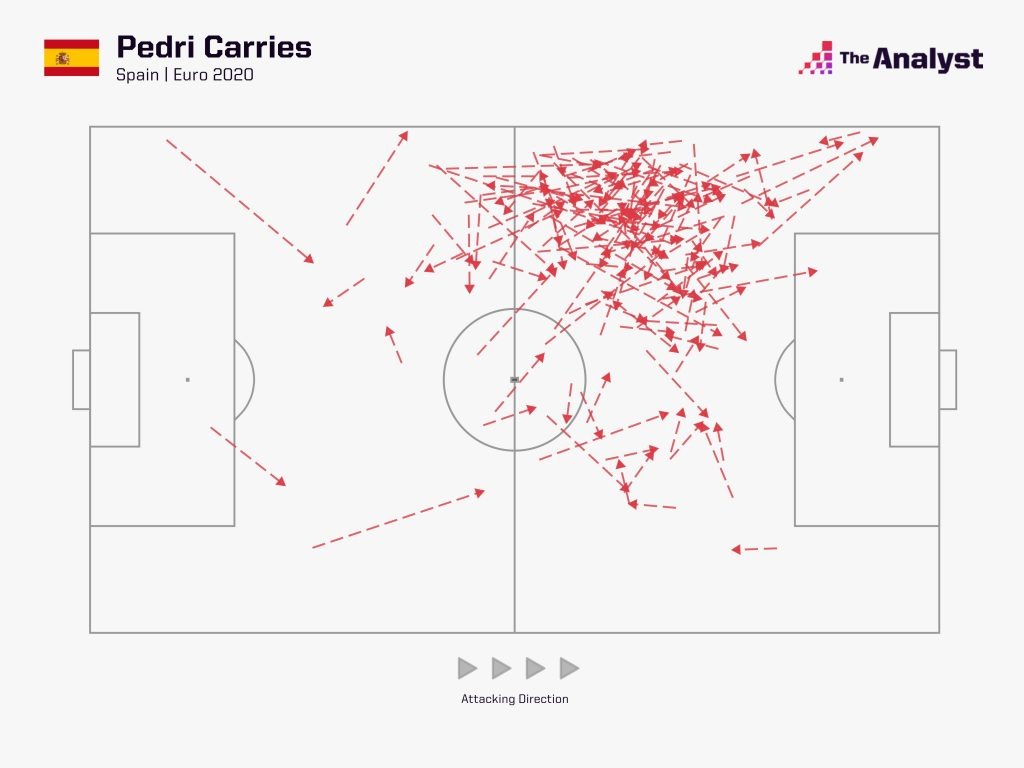
He’s extremely press resistant too, with extremely good close control and an ability to wriggle out of small spaces before launching Spain on their way.
To exemplify his skillset we can look at a passage of play against Slovakia. Pedri receives a square ball inside from Gerard Moreno and is quickly shut down by two Slovakian players converging on him from behind.
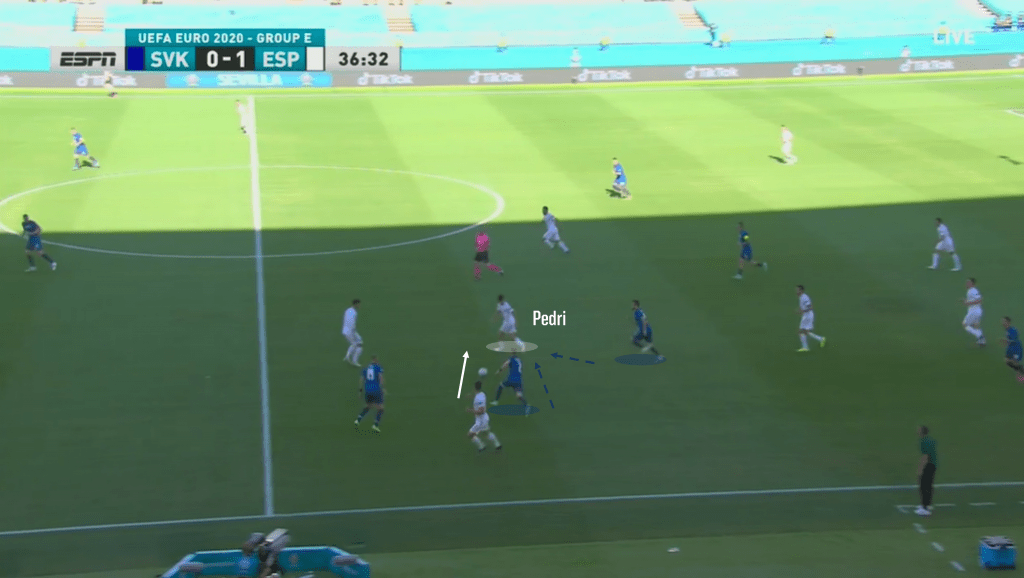
But Pedri displays impressive spatial awareness and senses the two players approaching him. With a deft flick, he chips the ball up and between the rushing defenders and cuts back on himself to maintain possession…
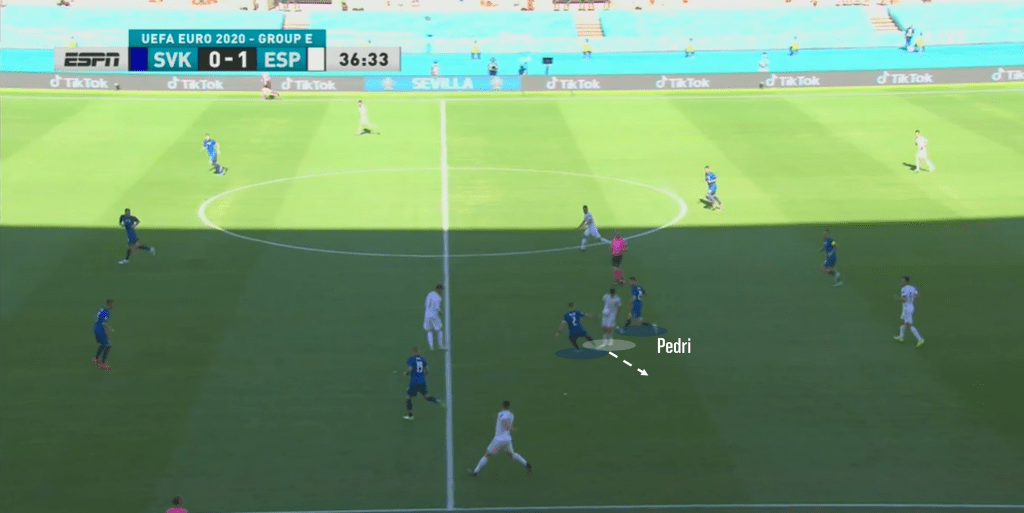
With possession secured, Pedri then smartly swivels sensing the space in the middle of the park. He drives into this space, carrying the ball with him and opening up the space on the pitch for Spain to switch the ball to right wing-back, Cesar Azpilicueta.
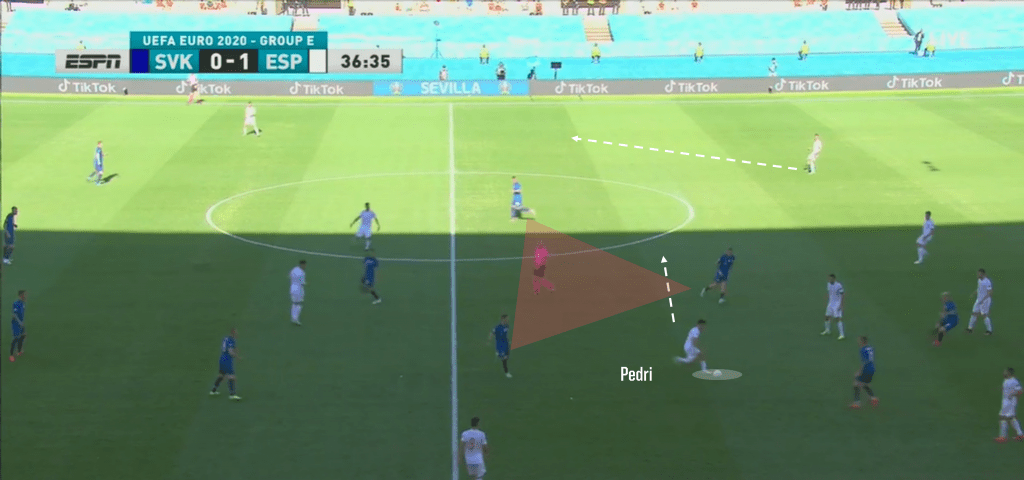
4. This Is a New Spain – But They Need to Take Their Chances
Despite a stuttering start against Sweden and Poland, there’s never really been any doubt that this Spain side is adept at creating high-quality chances. La Roja have already amassed more non-penalty expected goals (14.0) at Euro 2020 than in each of their trophy-winning performances at Euro 2008, World Cup 2010, and Euro 2012. That non-penalty xG tally of 14 is the highest of any side Euro 2020 by the way, with Italy next closest at 10.3.
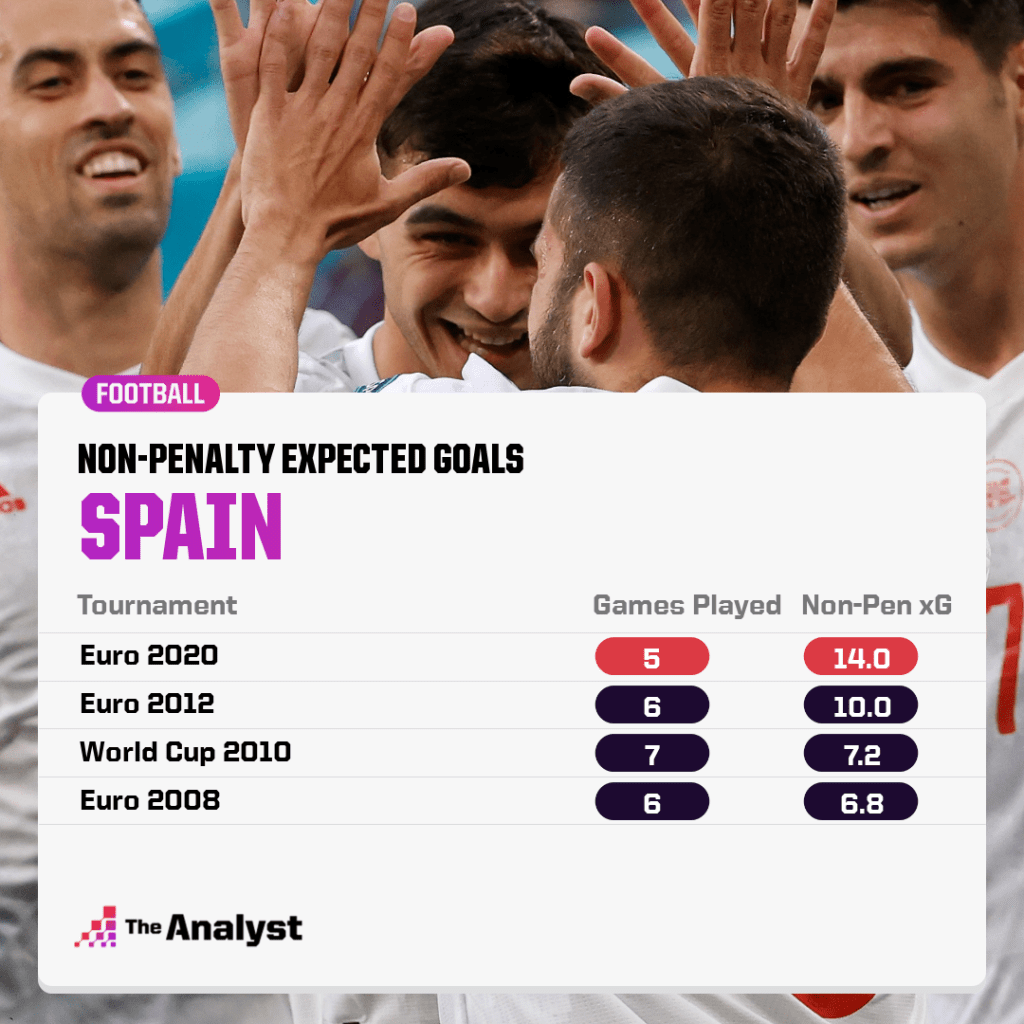
And they’re averaging almost 20 shots per game, with only Italy slightly ahead on 20.2, and those are coming at a strong 0.16 xG per shot. Only Portugal (0.17) and England (0.21) are averaging better quality shots.
But generating scoring opportunities and actually taking them are very different things. Spain snuck through against the Swiss after scoring once from 28 shots, the most they’ve ever recorded in a tournament game. And the lack of clinical edge has become something of a malaise for Spain throughout Euro 2020. Yes, they have 12 goals so far – more than any other team – but no side have benefited from more own goals in European Championship history than Spain (three) – and all three of those came in this tournament!
Dani Olmo (16) and Gerard Moreno (15) have had more shots without scoring than any other players so far, and Moreno’s 15 shots have an xG tally of 3.3, with only Cristiano Ronaldo’s (4.9) and Alvaro Morata’s (4.0) efforts having a higher total.
Moreno’s 3.27 xG underperformance is the worst of any player at Euro 2020 so far and with Alvaro Morata third on that list, Spain will need those two to find their form in front of goal. And fast.
| Player | Expected Goals | Goals | Underperformance |
|---|---|---|---|
| Gerard Moreno | 3.27 | 0 | 3.27 |
| Kylian Mbappe | 2.02 | 0 | 2.02 |
| Alvaro Morata | 3.95 | 2 | 1.95 |
| Burak Yilmaz | 1.66 | 0 | 1.66 |
| Gareth Bale | 1.57 | 0 | 1.57 |
5. A Spotlight on Italy’s Three in Midfield
Tournaments like the Euros often spring a few surprise performances and for some players they end up in the shop window with a potential move to a new club on the cards. At other times we discover new sides of already world-renowned players. One of those has been Marco Verratti and namely his ability to create chances.
Verratti is certainly not the first player many people think of when it comes to creating chances for others, especially when Mancini’s squad has players such as Lorenzo Insigne, Federico Chiesa and Domenico Berardi at their disposal.
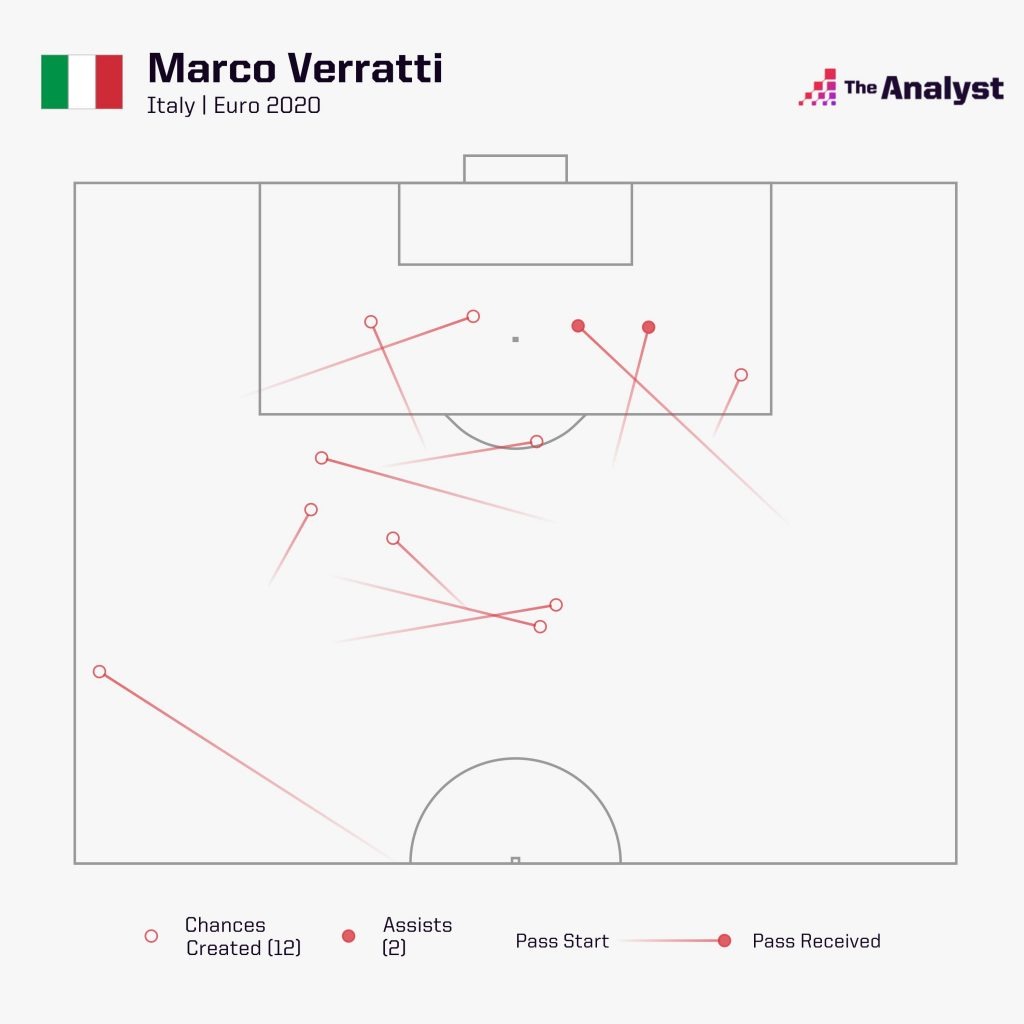
Despite missing the first two games, Marco Verratti is averaging a huge 4.7 chances created per match. For context, he created 1.5 chances per match for PSG in Ligue 1 last season and the chief chance creator himself, Kevin de Bruyne, sits behind him on 4.3 at these Euros.
Defensively, what can we expect in the middle of the park? Alongside Verratti in Italy’s three in midfield, we would expect to see Jorginho at the base of triangle and Nicolo Barella adjacent to Verratti, both of whom have been ever present with Sassuolo’s Manuel Locatelli chipping in with some game time.
Jorginho has had a really good tournament screening Italy’s defence, and he is just one interception short (13) of the competition leader N’Golo Kanté. Whilst we expect nothing to change here, and for him to only increase this number, what we could see is an added emphasis on Verratti or Barella to help provide support to Immobile as they look to cut off the supply from Aymeric Laporte and Pau Torres into Spain’s midfield.
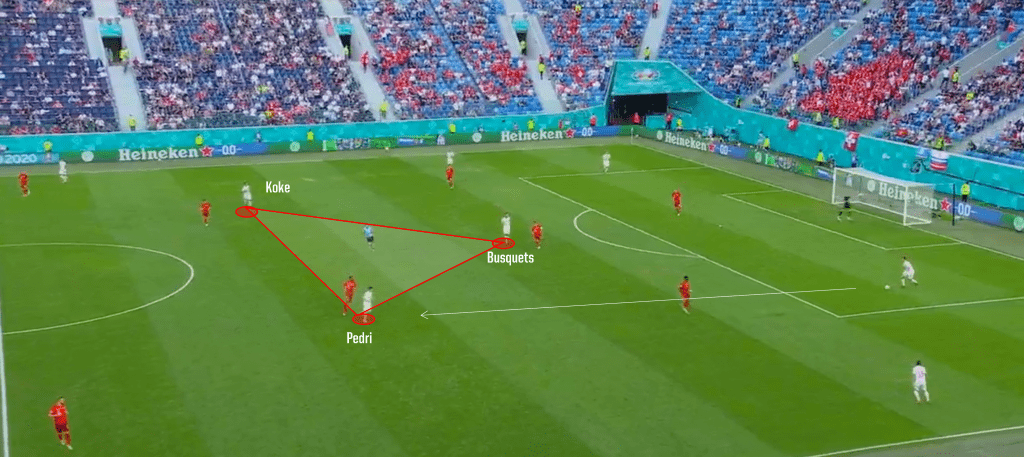
Switzerland set themselves up in a similar defensive shape against Spain and attempted to place a defender on each passing option as Spain looked to progress the ball. Pedri offers himself as the first receiver but is tracked well by Denis Zakaria.
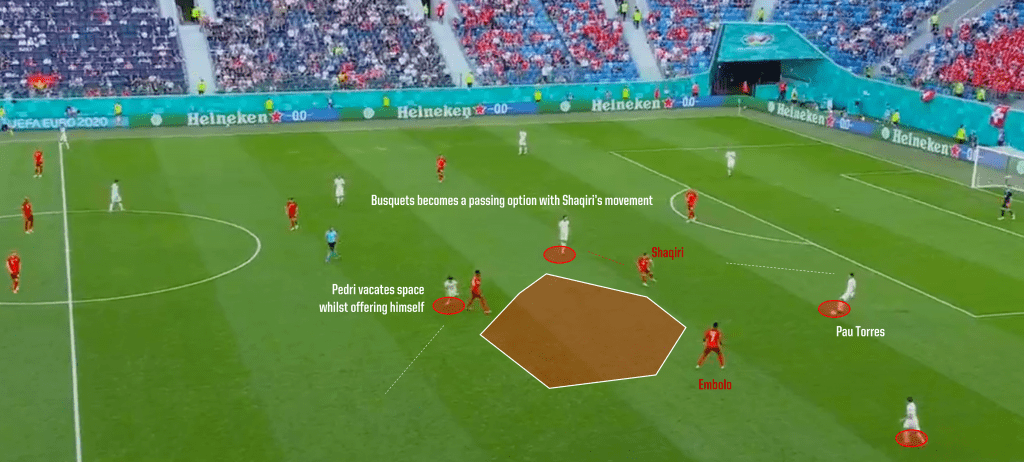
As Pau Torres brings the ball up and steps out of his penalty area, he forces Embolo to make a decision: does he step into close Torres down or does he track Jordi Alba, who has space ahead of him. Pedri attempts to vacate the area he was occupying to allow Torres to keep travelling with the ball if he wants to. In the meantime, Shaqiri, who was tracking Busquets has now come over to stop this, making Busquets available to receive. If Pau Torres then plays into Pedri, the youngster has got a whole lot of space to progress the ball through his already establish excellent carrying ability.
There were a few occasions in which Spain’s distributors travelled into the space in front of them to draw in defenders before then passing the ball to the open man. This allowed them to start an attack at speed. This has been key to their tournament, and it will be interesting to see how Mancini sets his midfield and front three up defensively to make Spain think differently.
Enjoy this? Subscribe to receive weekly exclusive content.
Design by Ruben Diaz.
